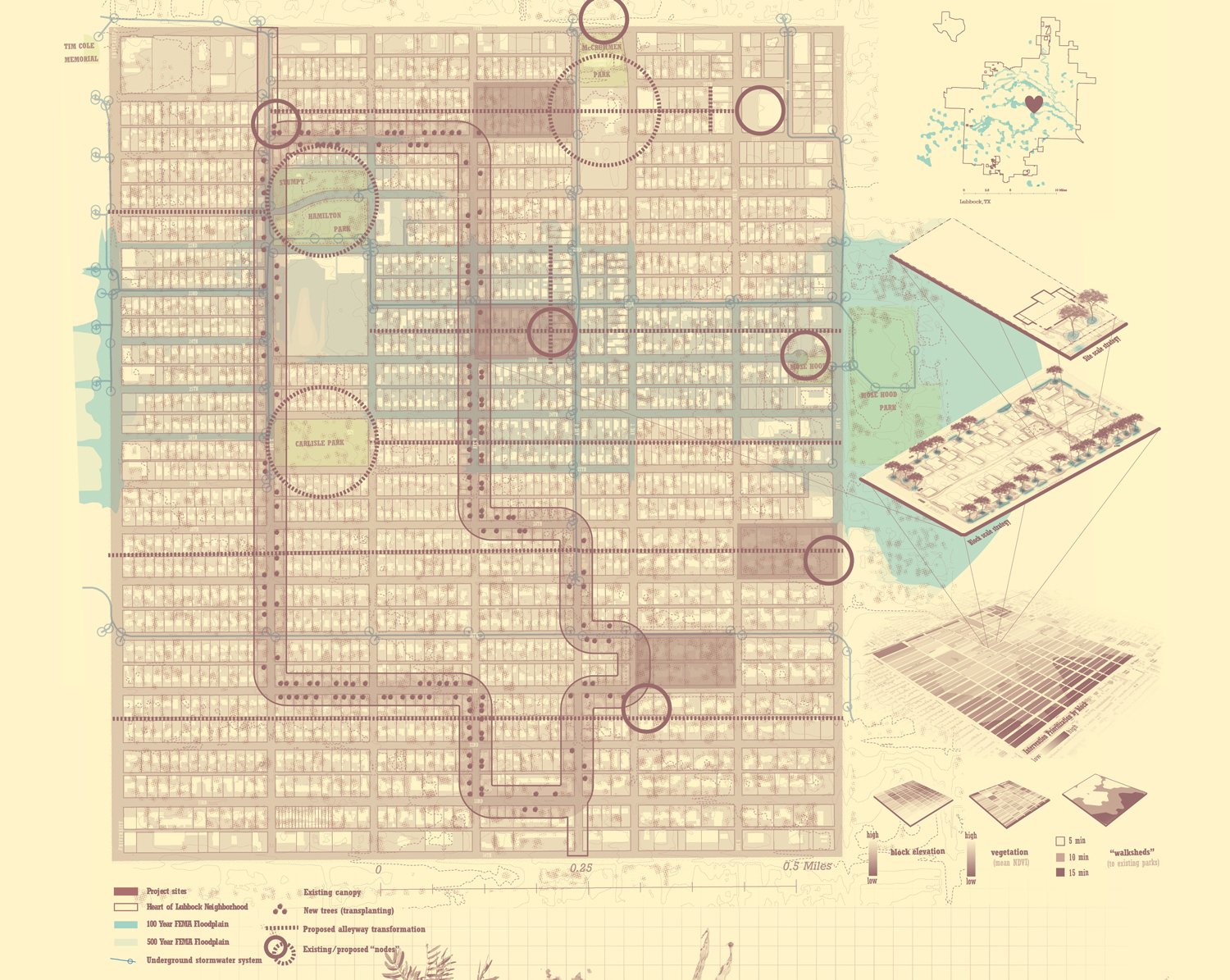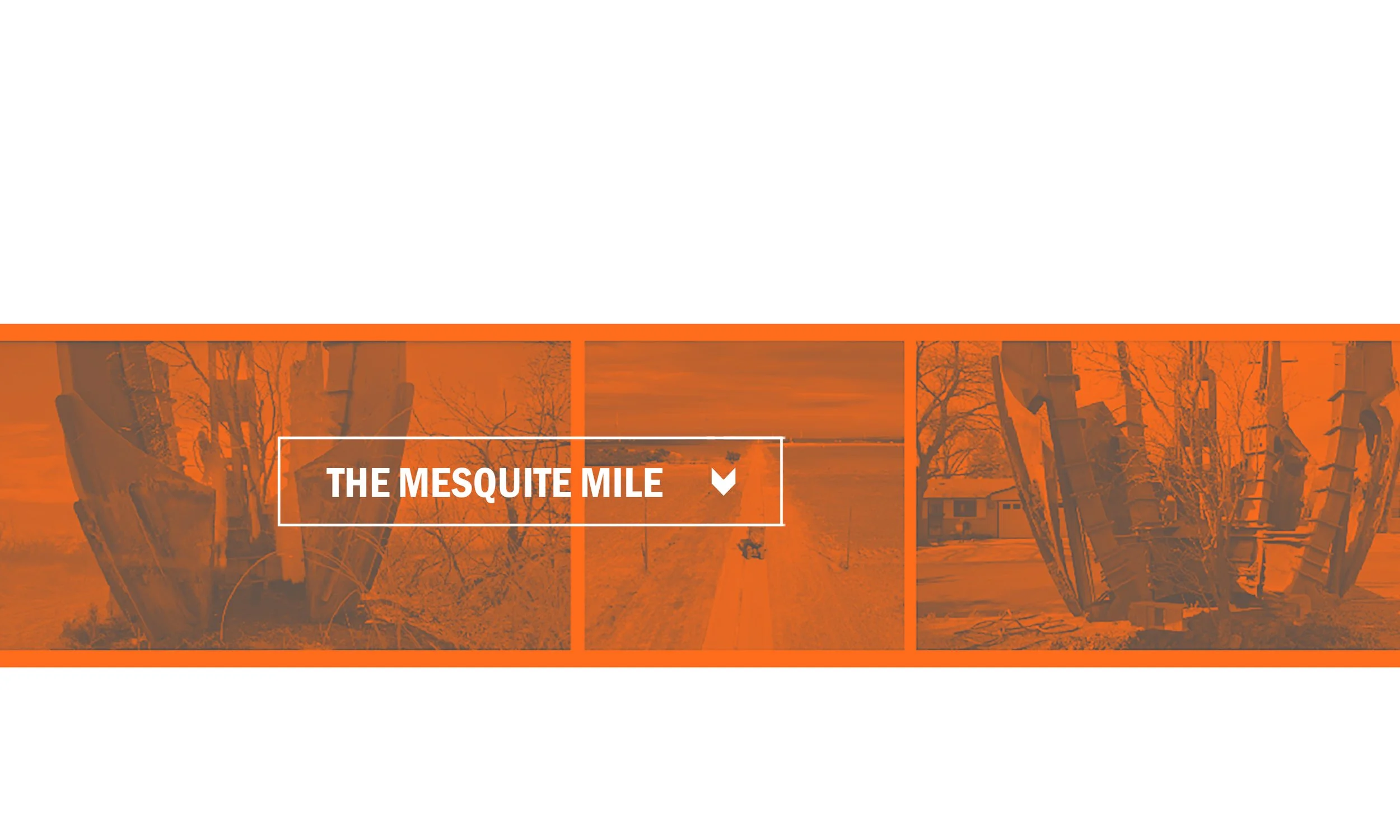The Mesquite Mile is a multi-phase public placemaking initiative that aims to relocate mature Mesquite trees from peri-urban agricultural land (where they are considered a nuisance) into the urban streetscape. Anticipating the realities of a hotter, dryer and more flood prone future, these simple acts of “assisted migration”, when replicated at the site, block and neighborhood scale, build urban resilience from the bottom up over time.
What we Asked:
How might we build socio-ecological and spatial resilience in ways that work with (rather than against) local norms and values?
What we Discovered:
Few plants have had a larger impact in shaping the land and history of the southwest than the Mesquite tree (Prosopis glandulosa). This wispy branched, flowering tree along with its protective thorns, sweet crimson-colored seed pods, and deep tap root is a member of the pea family, and thrives in hot, dry climates with sandy soils. The fruiting bodies of the tree, Mesquite beans, have long been a food staple for human and non-human inhabitants throughout the region. Today, Mesquite exists as both a savior and a scourge for ranchers and farmers, providing needed shade and food for livestock during the hottest, driest stretches of summer, but quickly invading open grasslands and pastures when undigested seeds are deposited in the fertile droppings of cattle. The Mesquite is routinely removed through controlled burning, mechanical or chemical means in agricultural landscapes.
For cities already hard hit by the harsh realities of a changing climate, the quantity and quality of the urban tree canopy exert direct influence on the habitability of vulnerable urban neighborhoods. Here, Mesquites are capable of catalyzing a range of benefits including increased shade, biodiversity and flood mitigation. This suggests there could be a win-win scenario: to strategically relocate mature trees from one context to another, and in so doing meet the needs of rural and urban communities simultaneously.
What we Did:
Working in collaboration with creative couple Travis Neel and Erin Charpentier, we are currently implementing local pilot projects, aligning a network of public and private stakeholders, and developing regional strategies for upscaling our efforts.
The Heart of Lubbock (HOL) neighborhood currently serves as our inaugural pilot community. HOL is a 1x1 mile square area in Lubbock, TX and is currently home to approximately 3400 residents. It contains over 1800 parcels and over 3,000 built structures. Despite having two public parks, many of the public streets in HOL lack pedestrian infrastructure such as sidewalks and canopy trees. HOL is currently considered a food-desert, and few residents report walking or biking in the neighborhood. Additionally, over 25% of residential parcels exist in the 100 year FEMA floodplain. Flooding is a regular occurrence during intense rain storms, which are expected to increase due to climate change, even as total yearly rainfall volume decreases. The recent closing of the Dupre Elementary school is likely to drive continued disinvestment and dilapidation in the local area. This underscores the urgent need to invest in alternative modes of public placemaking.
The long-term vision for this community is to install a series of “networked” interventions that pair mature Mesquite trees with carefully placed green stormwater infrastructure (GSI) features such as curb cuts, bioretention basins, and swales. Deployed in tandem with other public amenities and interpretive elements, our goal is to imagine how these tree planting efforts can impart a cohesive character to the overall neighborhood and eventually engender the formation of a public food forest. To date, we have transformed over an acre of private land into a public commons, and are in the process of upscaling our efforts with the support of additional funding partners.






What Else?
This project is a collaboration between Commonstudio and workabout.space, the creative practice of Travis Neel and Erin Charpentier
Follow project updates via instagram: @the_mesquite_mile
Supported in part by an Interchange Grant. Interchange is a program of the Mid-America Arts Alliance and funded by the Mellon Foundation
Special thanks to our student collaborators in the departments of Art and Landscape Architecture at Texas Tech University
For an in-depth exploration of Assisted MIgration, its history and its future implications, please read:
Interview with the team in Southwest Contemporary Magazine
View a short Documentary film project on the work HERE
Stills taken from documentation of a transplanted Mesquite Tree from Tahoka to Lubbock, TX (Source: The Mesquite Mile, Travis Neel, Erin Charpentier with Commostudio)




